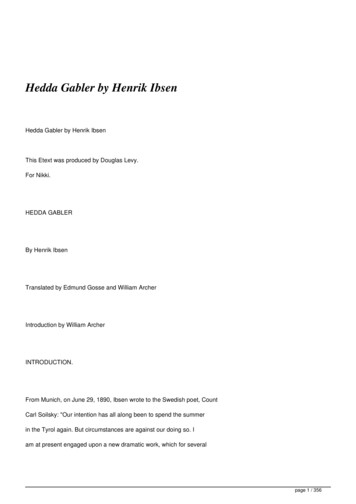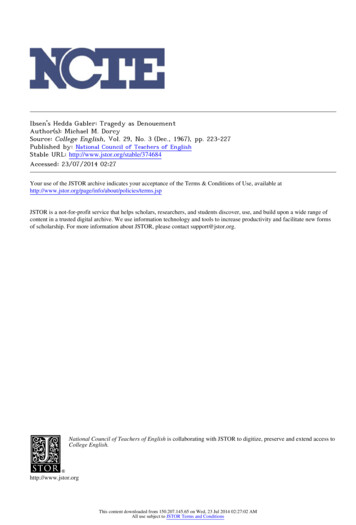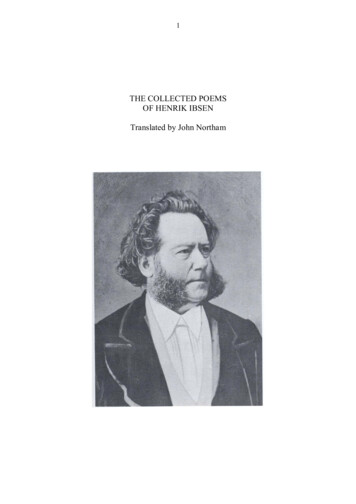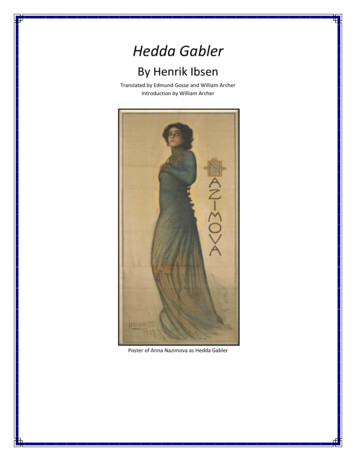
Transcription
Hedda Gabler by Henrik IbsenHedda Gabler by Henrik IbsenThis Etext was produced by Douglas Levy.For Nikki.HEDDA GABLERBy Henrik IbsenTranslated by Edmund Gosse and William ArcherIntroduction by William ArcherINTRODUCTION.From Munich, on June 29, 1890, Ibsen wrote to the Swedish poet, CountCarl Soilsky: "Our intention has all along been to spend the summerin the Tyrol again. But circumstances are against our doing so. Iam at present engaged upon a new dramatic work, which for severalpage 1 / 356
reasons has made very slow progress, and I do not leave Munich untilI can take with me the completed first draft. There is little or noprospect of my being able to complete it in July." Ibsen did notleave Munich at all that season. On October 30 he wrote: "At presentI am utterly engrossed in a new play. Not one leisure hour have Ihad for several months." Three weeks later (November 20) he wroteto his French translator, Count Prozor: "My new play is finished; themanuscript went off to Copenhagen the day before yesterday. . . . Itproduces a curious feeling of emptiness to be thus suddenly separatedfrom a work which has occupied one's time and thoughts for severalmonths, to the exclusion of all else. But it is a good thing, too,to have done with it. The constant intercourse with the fictitiouspersonages was beginning to make me quite nervous." To the samecorrespondent he wrote on December 4: "The title of the play isHedda Gabler . My intention in giving it this name was to indicatethat Hedda, as a personality, is to be regarded rather as her father'sdaughter than as her husband's wife. It was not my desire to deal inthis play with so-called problems. What I principally wanted to dowas to depict human beings, human emotions, and human destinies, upona groundwork of certain of the social conditions and principles ofthe present day."So far we read the history of the play in the official"Correspondence."(1) Some interesting glimpses into the poet's moodsduring the period between the completion of The Lady from the Seaand the publication of Hedda Gabler are to be found in the seriesof letters to Fraulein Emilie Bardach, of Vienna, published by Dr.page 2 / 356
George Brandes.(2) This young lady Ibsen met at Gossensass in theTyrol in the autumn of 1889. The record of their brief friendshipbelongs to the history of The Master Builder rather than to that ofHedda Gabler , but the allusions to his work in his letters to herduring the winter of 1889 demand some examination.So early as October 7, 1889, he writes to her: "A new poem begins todawn in me. I will execute it this winter, and try to transfer to itthe bright atmosphere of the summer. But I feel that it will end insadness--such is my nature." Was this "dawning" poem Hedda Gabler ?Or was it rather The Master Builder that was germinating in hismind? Who shall say? The latter hypothesis seems the more probable,for it is hard to believe that at any stage in the incubation ofHedda Gabler he can have conceived it as even beginning in gaiety.A week later, however, he appears to have made up his mind that thetime had not come for the poetic utilisation of his recent experiences.He writes on October 15: "Here I sit as usual at my writing-table.Now I would fain work, but am unable to. My fancy, indeed, is veryactive. But it always wanders awayours. I cannot repress my summermemories--nor do I wish to. I live through my experience again andagain and yet again. To transmute it all into a poem, I find, in themeantime, impossible." Clearly, then, he felt that his imaginationought to have been engaged on some theme having no relation to hissummer experiences--the theme, no doubt, of Hedda Gabler . In hisnext letter, dated October 29, he writes: "Do not be troubled becauseI cannot, in the meantime, create ( dichten ). In reality I am forever creating, or, at any rate, dreaming of something which, when inpage 3 / 356
the fulness of time it ripens, will reveal itself as a creation( Dichtung )." On November 19 he says: "I am very busily occupiedwith preparations for my new poem. I sit almost the whole day at mywriting-table. Go out only in the evening for a little while." Thefive following letters contain no allusion to the play; but onSeptember 18, 1890, he wrote: "My wife and son are at present atRiva, on the Lake of Garda, and will probably remain there until themiddle of October, or even longer. Thus I am quite alone here, andcannot get away. The new play on which I am at present engaged willprobably not be ready until November, though I sit at my writingtable daily, and almost the whole day long."Here ends the history of Hedda Gabler , so far as the poet's letterscarry us. Its hard clear outlines, and perhaps somewhat bleakatmosphere, seem to have resulted from a sort of reaction againstthe sentimental "dreamery" begotten of his Gossensass experiences.He sought refuge in the chill materialism of Hedda from the ardenttranscendentalism of Hilda, whom he already heard knocking at thedoor. He was not yet in the mood to deal with her on the plane ofpoetry.(3)Hedda Gabler was published in Copenhagen on December 16, 1890.This was the first of Ibsen's plays to be translated from proofsheets and published in England and America almost simultaneouslywith its first appearance in Scandinavia. The earliest theatricalperformance took place at the Residenz Theater, Munich, on the lastday of January 1891, in the presence of the poet, Frau Conrad-Ramlopage 4 / 356
playing the title-part. The Lessing Theater, Berlin, followed suiton February 10. Not till February 25 was the play seen in Copenhagen,with Fru Hennings as Hedda. On the following night it was given forthe first time in Christiania, the Norwegian Hedda being FrokenConstance Bruun. It was this production which the poet saw when hevisited the Christiania Theater for the first time after his returnto Norway, August 28, 1891. It would take pages to give even thebaldest list of the productions and revivals of Hedda Gabler inScandinavia and Germany, where it has always ranked among Ibsen'smost popular works. The admirable production of the play by MissElizabeth Robins and Miss Marion Lea, at the Vaudeville Theatre,London, April 20, 1891, may rank as the second great step towards thepopularisation of Ibsen in England, the first being the CharringtonAchurch production of A Doll's House in 1889. Miss Robinsafterwards repeated her fine performance of Hedda many times, inLondon, in the English provinces, and in New York. The character hasalso been acted in London by Eleonora Duse, and as I write (March, 5,1907) by Mrs. Patrick Campbell, at the Court Theatre. In Australiaand America, Hedda has frequently been acted by Miss Nance O'Neilland other actresses--quite recently by a Russian actress, Madame AllaNazimova, who (playing in English) seems to have made a notablesuccess both in this part and in Nora. The first French Hedda Gablerwas Mlle. Marthe Brandes, who played the part at the VaudevilleTheatre, Paris, on December 17, 1891, the performance being introducedby a lecture by M. Jules Lemaitre. In Holland, in Italy, in Russia,the play has been acted times without number. In short (as mighteasily have been foretold) it has rivalled A Doll's House in worldwide popularity.page 5 / 356
It has been suggested,(4) I think without sufficient ground, that Ibsendeliberately conceived Hedda Gabler as an "international" play, andthat the scene is really the "west end" of any European city. To meit seems quite clear that Ibsen had Christiania in mind, and theChristiania of a somewhat earlier period than the 'nineties. Theelectric cars, telephones, and other conspicuous factors in the lifeof a modern capital are notably absent from the play. There is noelectric light in Secretary Falk's villa. It is still the habit forladies to return on foot from evening parties, with gallant swainsescorting them. This "suburbanism," which so distressed the Londoncritics of 1891, was characteristic of the Christiania Ibsen himselfhad known in the 'sixties--the Christiania of Love's Comedy --ratherthan of the greatly extended and modernised city of the end of thecentury. Moreover Lovborg's allusions to the fiord, and the suggestedpicture of Sheriff Elvsted, his family and his avocations are alldistinctively Norwegian. The truth seems to be very simple--theenvironment and the subsidiary personages are all thoroughly national,but Hedda herself is an "international" type, a product of civilisationby no means peculiar to Norway.We cannot point to any individual model or models who "sat to" Ibsenfor the character of Hedda.(5) The late Grant Allen declared thatHedda was "nothing more nor less than the girl we take down to dinnerin London nineteen times out of twenty"; in which case Ibsen musthave suffered from a superfluidity of models, rather than from anydifficulty in finding one. But the fact is that in this, as in allpage 6 / 356
other instances, the word "model" must be taken in a very differentsense from that in which it is commonly used in painting. Ibsenundoubtedly used models for this trait and that, but never for awhole figure. If his characters can be called portraits at all, theyare composite portraits. Even when it seems pretty clear that theinitial impulse towards the creation of a particular character camefrom some individual, the original figure is entirely transmuted inthe process of harmonisation with the dramatic scheme. We need not,therefore, look for a definite prototype of Hedda; but Dr. Brandesshows that two of that lady's exploits were probably suggested bythe anecdotic history of the day.Ibsen had no doubt heard how the wife of a well-known Norwegiancomposer, in a fit of raging jealousy excited by her husband'sprolonged absence from home, burnt the manuscript of a symphonywhich he had just finished. The circumstances under which Heddaburns Lovborg's manuscript are, of course, entirely different andinfinitely more dramatic; but here we have merely another instanceof the dramatisation or "poetisation" of the raw material of life.Again, a still more painful incident probably came to his knowledgeabout the same time. A beautiful and very intellectual woman wasmarried to a well-known man who had been addicted to drink, but hadentirely conquered the vice. One day a mad whim seized her to puthis self-mastery and her power over him to the test. As it happenedto be his birthday, she rolled into his study a small keg of brandy,and then withdrew. She returned some time after wards to find thathe had broached the keg, and lay insensible on the floor. In thispage 7 / 356
anecdote we cannot but recognise the germ, not only of Hedda'stemptation of Lovborg, but of a large part of her character."Thus," says Dr. Brandes, "out of small and scattered traits ofreality Ibsen fashioned his close-knit and profoundly thought-outworks of art."For the character of Eilert Lovborg, again, Ibsen seem unquestionablyto have borrowed several traits from a definite original. A youngDanish man of letters, whom Dr. Brandes calls Holm, was anenthusiastic admirer of Ibsen, and came to be on very friendly termswith him. One day Ibsen was astonished to receive, in Munich, aparcel addressed from Berlin by this young man, containing, withouta word of explanation, a packet of his (Ibsen's) letters, and aphotograph which he had presented to Holm. Ibsen brooded and broodedover the incident, and at last came to the conclusion that the youngman had intended to return her letters and photograph to a young ladyto whom he was known to be attached, and had in a fit of aberrationmixed up the two objects of his worship. Some time after, Holmappeared at Ibsen's rooms. He talked quite rationally, but professedto have no knowledge whatever of the letter-incident, though headmitted the truth of Ibsen's conjecture that the "belle dame sansmerci" had demanded the return of her letters and portrait. Ibsenwas determined to get at the root of the mystery; and a little inquiryinto his young friend's habits revealed the fact that he broke hisfast on a bottle of port wine, consumed a bottle of Rhine wine atlunch, of Burgundy at dinner, and finished off the evening with onepage 8 / 356
or two more bottles of port. Then he heard, too, how, in the courseof a night's carouse, Holm had lost the manuscript of a book; and inthese traits he saw the outline of the figure of Eilert Lovborg.Some time elapsed, and again Ibsen received a postal packet from Holm.This one contained his will, in which Ibsen figured as his residuarylegatee. But many other legatees were mentioned in the instrument-all of them ladies, such as Fraulein Alma Rothbart, of Bremen, andFraulein Elise Kraushaar, of Berlin. The bequests to these meritoriousspinsters were so generous that their sum considerably exceeded theamount of the testator's property. Ibsen gently but firmly declinedthe proffered inheritance; but Holm's will no doubt suggested to himthe figure of that red-haired "Mademoiselle Diana," who is heard ofbut not seen in Hedda Gabler , and enabled him to add some furthertraits to the portraiture of Lovborg. When the play appeared, Holmrecognised himself with glee in the character of the bibulous man ofletters, and thereafter adopted "Eilert Lovborg" as his pseudonym. Ido not, therefore, see why Dr. Brandes should suppress his real name;but I willingly imitate him in erring on the side of discretion. Thepoor fellow died several years ago.Some critics have been greatly troubled as to the precise meaning ofHedda's fantastic vision of Lovborg "with vine-leaves in his hair."Surely this is a very obvious image or symbol of the beautiful, theideal, aspect of bacchic elation and revelry. Antique art, or I ammuch mistaken, shows us many figures of Dionysus himself and hisfollowers with vine-leaves entwined their hair. To Ibsen's mind, atpage 9 / 356
any rate, the image had long been familiar. In Peer Gynt (Act iv.sc. 8), w
Hedda Gabler by Henrik Ibsen Hedda Gabler by Henrik Ibsen This Etext was produced by Douglas Levy. For Nikki. HEDDA GABLER By Henrik Ibsen Translated by Edmund Gosse and William Archer Introduction by William Archer INTRODUCTION. From Munich, on June 29, 1890, Ibsen wrote to the Swedish poet, Count











